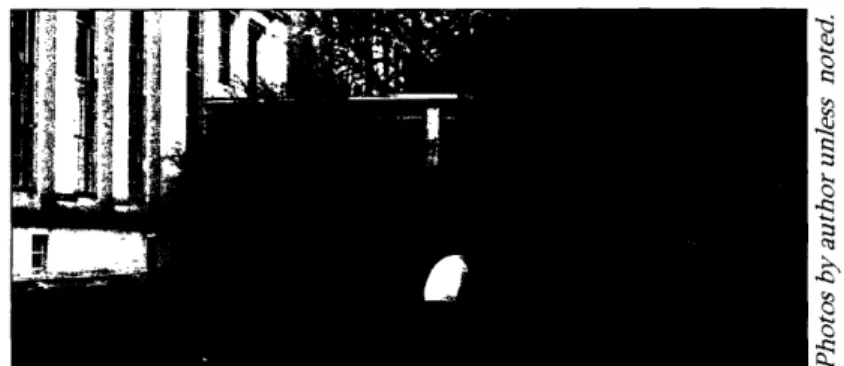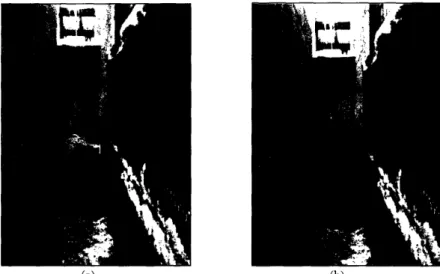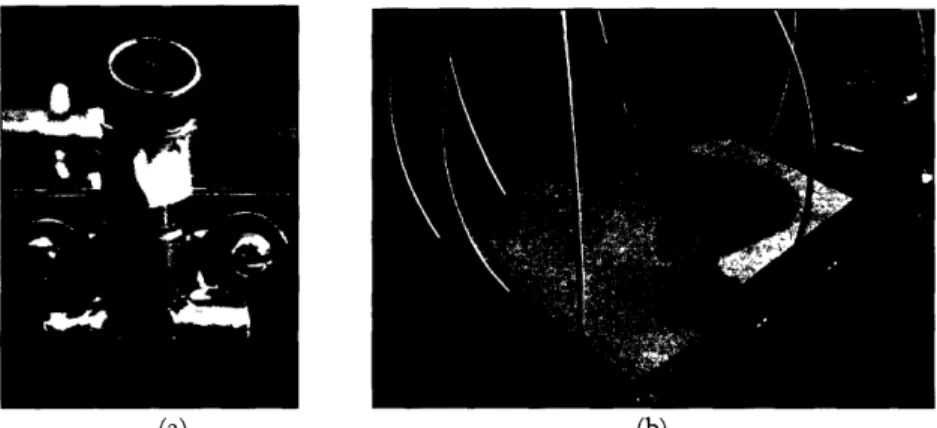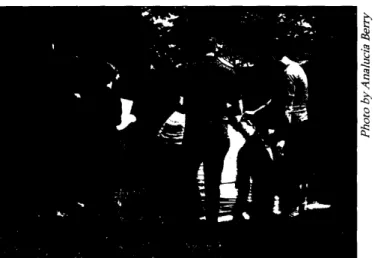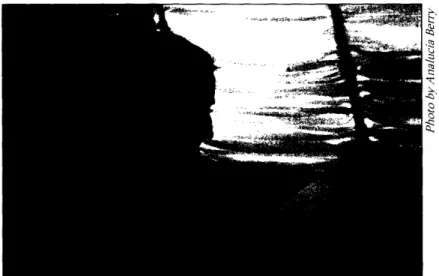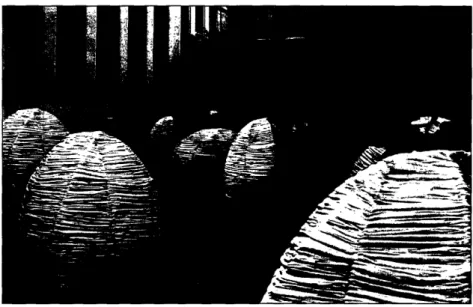Construction and Installation of Public Comfort Art: "Art as Sanctuary"
by
Sheila A. Longo
Submitted to the Department of Mechanical Engineering in Partial Fulfillment of the Requirements for the Degree of
Bachelor of Science at the
Massachusetts Institute of Technology
June 2005
©C) 2005 Sheila A. Longo. All rights reserved.
The author hereby grants MIT permission to reproduce and to distribute publicly paper and electronic copies of this thesis document in whole or in part.
Signature of Author... ...
Department of Mechani-cEngineering 6 May 2005
Certified by...--. .... /.... ...
Professor David R. Wallace Esther and Harold E. Edgerton Associate Professor Thesis Supervisor Accepted by ... :-- .- -.--.. .-.. ... -. ...
-Professor Ernest Cravalho Chairman, Undergraduate Thesis Committee
Construction and Installation of Public Comfort Art: "Art as Sanctuary"
by
Sheila A. Longo
Submitted to the Department of Mechanical Engineering on 6 May 2005 in Partial Fulfillment of the Requirements for the Degree of Bachelor of Science in Mechanical Engineering
Abstract
This paper illustrates the construction and installation of a public piece of art, hidden within which is an enclosed and private meditation space. In making the piece, the artist was influenced by the works of others as well as by her own previous works and personal experiences. The theory of deep touch pressure can be extrapolated to
associate encapsulation within small, enclosed spaces with relaxation and the relief of anxiety. Through the fluid process of aesthetic development, the work evolved
towards completion and fulfillment of the piece's goals. The result was a basket-like structure containing a close and comfortable space for decompression. Geared towards the MIT community, the piece also explored the effects of isolation and connectivity. Viewer interaction, made possible by a period of public display, remains a critical
component of this artwork. There are various directions in which to move forward with the investigation, one of which is to explore the dynamics of multiple pieces in a single location.
Thesis Supervisor: David R. Wallace
Table of Contents A bstract . . . ...3 1 Introduction ... 7 2 Background . . . ...8 2.1 Influences . . . ...8 2.2 Artistic Development ... 10 3 Theory . . . ...12 4 Procedure . . . ...13 4.1 O riginal Plan ... 13 4.2 Project Developments ... 13 4.3 Construction ... 14 5 Results ... 18 6 D iscussion ... 19 6.1 A rtists' Critique ... 19 6.2 Viewer Feedback ... 23 6.3 Personal Response ... 24 7 Conclusion ... 25
A cknow ledgem ents . . . ...27
1 Introduction
The Department of Mechanical Engineering at MIT has recently accredited course IIA, a curriculum "designed for students whose academic and career goals demand greater breadth, flexibility, and preparation for leadership than what is allowed under the traditional Mechanical Engineering program."[1] This thesis is the culmination of four years of study in the course IIA program, designed by the author to combine Mechanical Engineering and Visual Arts. The two departments intermingle in several areas, one example being the aesthetic decisions of industrial design. More significantly, the two are inseparable in the construction of large-scale, three-dimensional works of art. This paper will outline the artistic background, development, execution, and critique for the construction and installation of an interactive three-dimensional sculptural piece.
Figure 1: Installation of "Art as Sanctuary."
Approximately three feet in diameter, the work has an external appearance reminiscent of a spiral shell. Upon closer inspection, the viewer will notice the entrance to an enclosed meditation space, large enough to hold an adult in a comfortable sitting position. Soft, forgiving powder bead pillows provide the viewer with a close and secure sense of well-being and comfort.
I Q) C "I
t
IS :3 C13 (ZThis motivation for this particular piece of art stems from a deep and profound need of the individual MIT student, a need for decompression that often goes unacknowledged or unsatisfied. Anxiety and stress are an everyday battle for many students. In a 2001 study for MIT's Mental Health Task Force Report, three-fourths of the students surveyed acknowledged having had an "emotional problem that affected their daily functioning at MIT." [2] Support services and counseling are readily available, but these may be less viable options for those possessing an inherent pride in self-sufficiency. The piece offers any viewer the opportunity to enter the meditative space and be comforted by the visual and tactile experience of the enclosure. The viewer is encouraged to use the space as a means to soothe his own mind by simple and literal immersion in the work.
2 Background
Art and sculpture have long been a means of meditation. Focused reflection on an artwork will predictably result in an emotional response by the viewer to the composition, the material, the choice of color, and other artistic decisions. Whether one finds peace in contemplating a Renaissance oil painting or minimalist rock garden, it is unarguable that well-composed and beautiful works of art can have a calming effect on the receptive viewer. Furthermore, interactive art can produce an even wider range of emotional responses. With physical sensations augmenting the viewer's visual impressions, a deeper awareness of and closeness to the essence of the piece may be attained.
2.1 Influences
What interests me is the opportunity for all of us to become something different from what we are, by constructing spaces that contribute something to the experience of who we are. - Richard Serra
Many other artists have investigated the possibilities of viewing a work from within as well as without; particularly notable are the large-scale sculptures "Torqued Ellipses" by Richard Serra. Three of these are currently housed at the Dia Foundation's Beacon, New York location. Each sculpture is composed of steel ellipses, whose sixteen-feet-high walls roll and twist at various angles. [3]
One of the most appealing aspects of Serra's work is that the majority of his pieces cannot be appreciated solely from a singe exterior view. Rather, the artist's very intention is for the viewer to walk through, around, and into his massive steel configurations. With a great deal of influence from his appreciation of Zen gardens, Serra's sculptures reveal a "growing preoccupation with work that [is] defined through the processes of its reception." [4] Full comprehension results from the required interactivity with the piece, which is a also key feature in this thesis work.
In Fall 2003's "Introduction to Sculpture" class at MIT, architecture student Marco Marraccini constructed a small meditation space wedged in a gap between two buildings. This architectural approach to the need for a personal meditation space "was driven by the effects of diffuse light, insulation, and sound."[5] Smooth and simple inside, the space consisted of a carpeted seat and a semi-translucent window. The entrance was located at the foot of the seat, deterring the more claustrophobic of viewers.
Marraccini carefully considered the location of his piece, which, "[bleing sandwiched between two concrete block buildings[,] allowed for both thermal and psychological insulation...The progression from the courtyard to the space ([via a] gravel path) was intended to act as a moment of decompression." In addition, the muffled noise of the internal systems of the two buildings yielded "an unexpectedly subduing effect." [6] As a place apart from the hectic everyday, the work was very
successful. However, Marraccini's piece did not address comfort or close pressure. Entering and exiting the space were somewhat difficult, as demonstrated in Figure 2a.
(a) (b)
Figure 2: A viewer enters Marraccini's mediation space during the final class review. [7]
2.2 Artistic Development
The development of this project has roots in previous works by the author in her MIT coursework. In the spring of 2002, the oversized three-dimensional replica of Harold E. Edgerton's photograph, "Milkdrop Coronet" was installed in response to the lack of water fountains on the MIT campus, and allowed viewers to step into the famous ring of milk.
An assignment demanding the use of magnets resulted in "The Phoenix Rising," a commentary on the cyclical nature of weekly problem set stress. In this piece, a clay bird, suspended by wires and affixed with internal magnets, would fall to pieces when disturbed. The viewer would then have to rebuild the bird - a somewhat involved process.
In a multi-sensory installation, "Steel Hive," originally untitled, was displayed suspended in the center of a dark room. Blue LEDs softly lit the interior of the hive, revealing small spirals and tangles of steel wire. The exterior of the hive was wrapped in many layers of muslin, which had been soaked in tea leaves for an olfactory effect. Viewers were encouraged to touch the piece, whose interior was slightly cooler than the room, due to pieces of ice tucked within the hive.
(a) (b)
Figure 4: Close-up views of "Steel Hive" highlight the complexities of the interior (a), and the cloth wrapping (b).
"Art as Sanctuary" draws from each of these and other works, most
significantly in the communication of a hidden and/or explorable interior. Another
prominent theme is the presentation of a familiar object on a greatly magnified scale. The wrapping of cloth from "Steel Hive" has been elevated to weaving, and the sensory involvement of the viewer is not only preserved but emphasized as well.
3 Theory
It is confirmed scientifically that mild to medium pressure has a soothing effect on over-stimulated nerves, as evidenced by Temple Grandin's deep touch pressure device. This squeeze machine was developed by an autistic woman who noticed the calming effect of a similar machine on cattle being branded. Grandin created a version "to help [herself] overcome problems of oversensitivity to touch, and that allays [her] nervousness." [8]
To use the machine, the participant lays face-down in a V formed by two mattresses, and controls the operation that squeezes the mattresses together. Additionally, the user maintains "a more complete sense of self-control in the context of the machine" as she controls the pressure exerted, and can choose when to begin and end the session. Fifty-five percent of the participants in Grandin's "sensory perception experiment" described the squeeze machine experience with words relating to relaxation and weightlessness. Only five percent of the subjects experienced claustrophobia in response to the machine. [9]
An artistic twist on Grandin's squeeze machine is the "Squeeze Chair Project" begun by Wendy Jacob in 1998. [10] Jacob, an assistant professor in the Art and
Architecture department at MIT, worked with Grandin to transform the utilitarian
directness of Grandin's squeeze machine into the ultimate comfy chair, one that embraces the sitter as the large armrests inflate. While Jacob's work focuses on
"distilling and replicating human intimacy," one art review states that the Squeeze Chair and other works deliver the viewer to "a private, psychic space free from imposed societal and sexual codes." [11] A sculptural piece emphasizing physical pressure as a means to depart from perceived pressures and anxieties seems so absurdly accurate that the success of Jacob's work is no surprise.
While the piece described herein does not involved deep touch pressure, its central theme revolves around a small, confined, and comforting space within the sculpture itself. This is assumed to have similar effects of relaxation and anxiety-relief. 4 Procedure
4.1 Original Plan
With the intention of targeting the MIT environment, groundwork was begun
on the project before the final exterior shape was determined. The original grant proposal states that "the exterior will be hard, weather-proof, and take on an oversized, yet familiar shape, rather than an abstract blob." The necessity of a hard exterior was tempered by the aim to minimize weight for ease of transport. As for the interior, the initial plan called for a welded steel frame to form a raised seat and the surrounding structural ribs. The use of powder bead pillows, chosen for their forgiving absorption of the body, was the primary motivation for the meditation space. The space was also intended to be comforting without being claustrophobic.
4.2 Project Developments
In product design, the "internal search," or brainstorming, stage of concept generation can be a very loose and organic process. [12] The same is true for the development of aesthetic ideas. One minor improvement will lead to another,
realization of the artist's intentions. Due to the limited funds available from the artist and from a Director's Grant from the Council for the Arts at MIT, steel was abandoned in favor of cardboard and aluminum. The obvious differences between these materials and steel called for alterations to the seating place. The most significant adjustment was lowering the seat height nearer to ground level. Standard chair height, while feasible with a welded steel frame, would not be as elegantly accomplished with layers of cardboard. Consequently, the entire piece became much
shorter, in tune with the theme of close comfort.
As the project progressed, the 'familiar shape' varied from human heart to fish head, before the spiral shell was chosen. The particular inspirational shell can be categorized as a 'worry stone,' a smooth object fitting in the palm of the hand, with indentations or other features for the fingers to mull over. In this case, the relationship is inverted so that the worry object may now hold the worrier. Additionally, the spiral is quite prevalent in nature, allowing many to consider it an organic symbol of creation and rebirth.
4.3 Construction
Construction began with many layers of cardboard. Rather than shape and weld a steel frame from which a seat would be suspended, three-foot-square pieces of
corrugated cardboard were layered and affixed with Elmer's glue. With
approximately twenty sheets in place, the next ten layers included cut-outs to form the seating area. The two contoured depressions were intended to guide the user into relaxed, bent-knee posture. A low back support of about thirty half-circle layers was added to complete the seating base. This configuration also allowed the viewer to sit cross-legged, or to recline moderately onto the backrest.
Figure 5: Layered backrest of the cardboard base.
One corner of the square base was eliminated to allow for a shoe-removal threshold. The cardboard base was then sprayed with 3M Super 77 multipurpose adhesive, and a layer of fabric was applied.
To attain the goals of lightness and ease of construction and disposal, right-angled and flat punched zinc-plated aluminum were cut and attached with bolts to form a tray for the cardboard base. An extra aluminum 'arm' protruding from the top of the cut-off corner would be used for the outer edge of the spiral.
Figure 6: Aluminum 'tray' used to support seating base and provide connection points for CPVC pipes.
The angled aluminum provided a vertical connection point for the CPVC framing. This was accomplished with the use of half-inch copper pipe fittings. A tee
connected the tee to a forty-five degree elbow fitting. This fitting combination was attached to the angled aluminum with an omega-shaped copper piece.
Once all eight of these fitting combinations were in place, four CPVC pipes were placed into the elbow fitting and bent over the base tray to attach to the fitting on the opposite side. The resulting shape was modified by connecting the tubes at three different points in the peak of their arcs.
(a) (b)
Figure 7: Eight fitting combinations (a), were used to anchor four CPVC tubes to the base (b).
Five-inch wide strips of the canvas-like fabric were cut into five-foot lengths. Some seventy to eighty of these strips were used to weave around the CPVC pipes, leaving the cut-off corner exposed.
(a) (b)
An extra three-foot piece of CPVC was woven onto the inner part of the doorway, in order to visually close off the interior space. At the two open ends of the spiral, an ordered method of knotting the strips together was implemented, and the excess fabric removed to make a finished edge.
Perhaps the most practical element of the piece, the waterproofing developed into a critical feature as weather forecasts for the installation period became increasingly rainy. A layer of semi-clear plastic sheeting was sewn into the interior of the woven structure. The seams were covered with clear duct tape and the panels were attached to a base piece of sheeting located beneath both the cardboard and the aluminum tray.
Twenty-seven powder bead pillows, measuring fourteen inches square, were sewn together in rows of three. These blocks of green, orange, and yellow pillows were then sewn to the fabric-covered cardboard inside the structure. The thread was chosen so that any tension placed on the pillow-to-fabric connection would cause the thread to break, rather than the stretchy pillow material. Though repairs would be inevitable, the ingestion hazards and difficulty of cleanup of the powder beads would be avoided. The rows of pillows were attached to the cardboard base, loosely following the contours of the seating depression and backrest. Three or four strings of pillows were anchored at only one end, allowing the viewer to rearrange the pillows around his body without fully removing them from the base.
5 Results
aN
a.2
a
(a) (b) (c)
Figure 9: A series of photographs outlines the approach to the piece from Building 2.
Approaching Building 14 from Building 2, the viewer enters a glass walkway. The courtyard on the viewer's right offers a glimpse of grass, trees, and a glimmer of
Boston across the Charles. The piece was located in this courtyard, which was acknowledged by many to be unused and rather overlooked. To access the work, the viewer must exit the building and walk along a raised slate sidewalk, next to the Hayden Library. Between the pine trees, the bright colors of the interior pillows catch the viewer's eye. However, the viewer must continue walking past and away from the piece, in order to descend to ground level and enter the courtyard.
Another perspective is presented to the viewer as he advances through the grass towards the work. Although other parts of campus may be windy on this particular day, the courtyard possesses a calming stillness. From this angle, the viewer
will come upon the title placard, staked into the grass in front of the piece. The title,
"Art as Sanctuary," gives the viewer some insight into the central theme being explored. Circumnavigating the work gives the viewer a chance to inspect the woven exterior, perhaps feeling the tightness of the knots and the looseness of the individual strips.
(a) ( b)
Figure 10: Exterior views of the entrance (a), and the woven fabric (b).
At the entrance, another placard requests the viewer to remove his shoes upon entering. At this point, the viewer may choose to enter the piece and settle himself into the embrace of the pillows, arranging them as he sees fit. If the viewer should choose a position that allows a line of sight through the entrance, the row of trees and raised sidewalk limit the extent of outside distractions. Inside, the brightness of the orange, green and yellow pillows reflects off the plastic walls, which crinkle slightly
with the viewer's movements. 6 Discussion
6.1 Artists' Critique
On the first day of the installation, a small review was held. The critiquing body consisted of two graduate students from the department of Art and Architecture, as well as a PhD candidate in the MIT-Harvard division of Health Sciences and Technology. The critique was very informal, beginning with the approach to the piece from the glass walkway. The reviewers were given the opportunity to explore the piece, experience the pillow-filled interior, and observe others enter and sit. Several intriguing points were raised, as well as ways in which to move forward with the work. At a later point, Mechanical Engineering professor and thesis supervisor
David Wallace reviewed the piece. The comments of the four are combined and summarized below.
U~
0Z
Figure 11: Reviewers discuss the piece with the artist.
First impressions of the piece were associations with cocoons, beehives, and African basketry. To accentuate the spiral features of the shell, extension of the outer arm into a larger arc was suggested. This would offer a longer transition time from the outside to the inside. While a stronger threshold has positive aspects, it was pointed out that the heightened sense of mystery and uncertainty may prevent the average viewer from exploring the interior of the piece. Additionally, the interior
configuration, when experienced from the inside, allows the user to feel protected without feeling trapped.
An unexpected benefit was the movement of the bubble-like structure as someone shifts around inside. Since the flexibility of the material is concealed by the weaving, the movement is at once surprising, mysterious, and comical. This intrigue is carried to the interior, where the user can explore the almost biological feel of the beads, elusive bubbles under the surface of the fabric. Some felt that the plastic walls detracted from the tactile experience. The coziness of the pillows could be better
complemented by incorporating woven fabric on the interior walls. Concerns were raised about the piece feeling "inside-out." There is, however, something appealing in the possible implications of this contradiction.
Figure 12: Full view of the project, with interior visible.
The reviewers agreed that the majority of the mystique of the piece remains on the exterior. Once inside, the user is hidden and warned of any approaching figures by the shadows projected on the structure. On the outside, viewers tend to advance cautiously, uncertain about whether or not the piece is occupied. The possibility of revealing the interior contents to the outside viewer is interesting, but contradicts a major goal of the work: to provide a protected meditation space in which one might find comfort and security.
As an installation, the site choice of the piece was deemed effective, yet not fully explored. The chosen position is protected by the line of pine trees while remaining visible to passers-by in the building or on the street. To emphasize the aesthetics of the view from the street, placement under the dogwood tree was suggested. If the tree were in bloom, there would be a satisfying sense of symmetry between the white blossoms and the white fabric, as well as between the shape of the piece and the protective sweep of the lower branches. In its chosen location, the work
11 1-'I'll IG CZ _r , I1 (Z
seems to have just "touched down" from elsewhere. There is little relation between the piece and the ground it sits on. An improvement would show more intention, and
could involve placing the work in a depression, as if it were burrowed down into the ground. The viewer would possibly have to crawl downwards to enter the piece, which could have a very strong effect. Again, this may prevent the average viewer
from reaching the interior.
Due to its placement in the courtyard visible from a primary thoroughfare, the piece entices the viewer to pass through an otherwise unnoticed space. In this case, however, having only one structure may not be a strong enough image to emphasize the peacefulness of this neglected space. More than one reviewer believed that a very powerful statement could be conveyed if the courtyard were dotted with many iterations of the existing work. With multiples, the individual viewer gains a heightened sense of anonymity; he is more hidden as one among many. Yet even while isolated, he is in the company of like-minded people, each in their own bubble. Since there is no way to mass-produce these structures, the variations inherent in the process would add to the attraction. Some structures could be smaller, taller, or longer, to accommodate the individual preferences of different people.
Discussing the various structures possible, the reviewers introduced several approaches for continued development of the work. The portability of the pieces was considered, as well as techniques with which the structure could be shaped to an individual's body. Likened to urban tumbleweed, the project could be expanded by "abandoning" it somewhere, and documenting where it ended up, and what modifications were implemented by those who came across it.
6.2 Viewer Feedback
The piece was on display for nearly a week, and many people had the opportunity to experience the installation. Viewer feedback has been very positive. Not everyone is against the use of plastic for the interior walls. Some feel it offers a sense of protection not allowed by the woven fabric alone. One viewer commented on the satisfying experience of disconnectedness, though she could still hear the sounds of the world around her.
<h'
-21o
Figure 13: A viewer uses the meditative space for comfort and contemplation.
One viewer reported a difficult problem: his friend had gone in first and would
not relinquish the comfort of the interior. Several people mentioned that they
planned to take a nap in it at some point during the display period. Yet another viewer succinctly declared his perception of the piece as "relaxing, comfortable, and surprisingly dry." Even through scattered showers, the pillows remained protected by the plastic layer. The pleasantness of the enclosure was appealing to all, and many found themselves wishing they could have lingered inside the space.
6.3 Personal Response
In any project, there is always a moment of relief upon completion, followed quickly by a vision of future iterations. The artist cannot help but reflect on the myriad of possibilities for expansion, continuation, and further improvement. With the suggestions of the reviewers in mind, a photo collage of the courtyard containing multiple pieces was prepared.
Figure 14: Artist's rendition of courtyard filled with multiple sculptures.
Although the image created is quite remarkable, multiple meditation spaces are not necessary for the success of this project. It is enough that a handful of students have found respite and comfort within the unique enclosure. The sense of loneliness accompanying a period of anxiety is made more poignant by the emptiness of the lawn. By first delving into the isolation of the courtyard, the viewer may reach a deeper feeling of restoration from being encircled by the close meditation space.
As a satisfying way to move forward, the next version would explore the myriad of possibilities generated by the original vision. An investigation into hard-bodied pieces that more closely resemble a shell or other 'worry object' would be extremely gratifying. Examination of the effect of more complicated entrances on the viewer's approach and posture is also an intriguing theme to consider.
7 Conclusion
From proposal to installation, the development of this project consumed hours upon hours of time. Through the course of these many hours, the student's critical need for self-decompression was uncovered, examined, and fulfilled. Though the piece has certainly strayed from its earliest conception, all modifications, drastic and otherwise, occurred as the natural results of continually re-examining the intentions of the work.
In an interactive work such as this one, the sculpture is not complete without the presence of a participant. Continual use of this work has been very effective in maintaining and cultivating the fundamental nature of the project. Viewers observed
many unanticipated connections which now contribute to the scope of the piece.
Though the installation has been concluded, the work is, at time of writing, still in use in a new location. Within five hours of placement in a dormitory
Acknowledgements
I would like to take a moment to thank the following people, for the following reasons:
o Professor David Wallace, for being the best thesis supervisor I ever had. o Woodie Flowers, Joe Dahmen, Coryn Kempster, and Chris Cassa, for
'formally' reviewing the piece in progress and/or installation. o Susan Cohen, Director of the Council for the Arts at MIT, for her
generosity and goodwill.
o Joe Graham, James Houghton, the East Campus Tool Committee, and craigslist.org, for workspace, tools, and materials.
o Dalis, Marcos Ojeda, and Harold Cooper, for installation assistance. o Analucia Berry, for her photography and friendship.
o Schuyler Senft-Grupp, Matt Moskwa, Janet Lieberman, and the rest of First East, for humor, perspective, and discerning questions.
o Truman Rossi, for believing in the project from the first stack of cardboard. o Jim Longo, for tricking me into going to MIT in the first place.
o Kitty Barnett, for good genes. o Jessica Longo, for understanding. o Mike Barrett, for everything.
1. J t; OI I ,'I
References
[1] Mechanical Engineering at MIT 2005. [12] Eppinger, S. D. and Ulrich K. T.
Massachusetts Institute of Technology. Product Design and Development. 2nd 5 May 2005. <http://me.mit.edu/ Edition. p. 119. McGraw-Hill. 2000.
UGradProgram/Course2A.htm> [2] Benedict, et al. MITMental Health
Task Force Report. 6 November 2001.
5 May 2005.
<http://web.mit.edu/chancellor/mhtf/>
[3], [4] Cooke, Lynne. "Richard Serra." Essay. Dia Art Foundation. 1995-2005. 3 May 2005.
<http://www.diabeacon.org/exhibsb/
serra/essay.html>
[5], [6] Marraccini, Marco. "Re: Intro to
Sculpture class." E-mail to Sheila Longo.
2 May 2005.
[7] This material was created or adapted from material created by MIT faculty member Sanjit Sethi, Professor. ©) 2003 Sanjit Sethi.
[8], [9] Grandin, Temple, Ph.D. "Calming Effects of Deep Touch Pressure in Patients with Autistic Disorder, College Students, and Animals." Journal of Child and Adolescent
Psycho-pharmacology. Volume 2, Number 1,
1992. Mary Ann Liebert, Inc.
[10], [11] "Wendy Jacob: Squeeze Chair." Essay. Creative Capital Foundation. 2003. 3 May 2005.
<http://channel.creative-capital.org/ project_31 .html>
